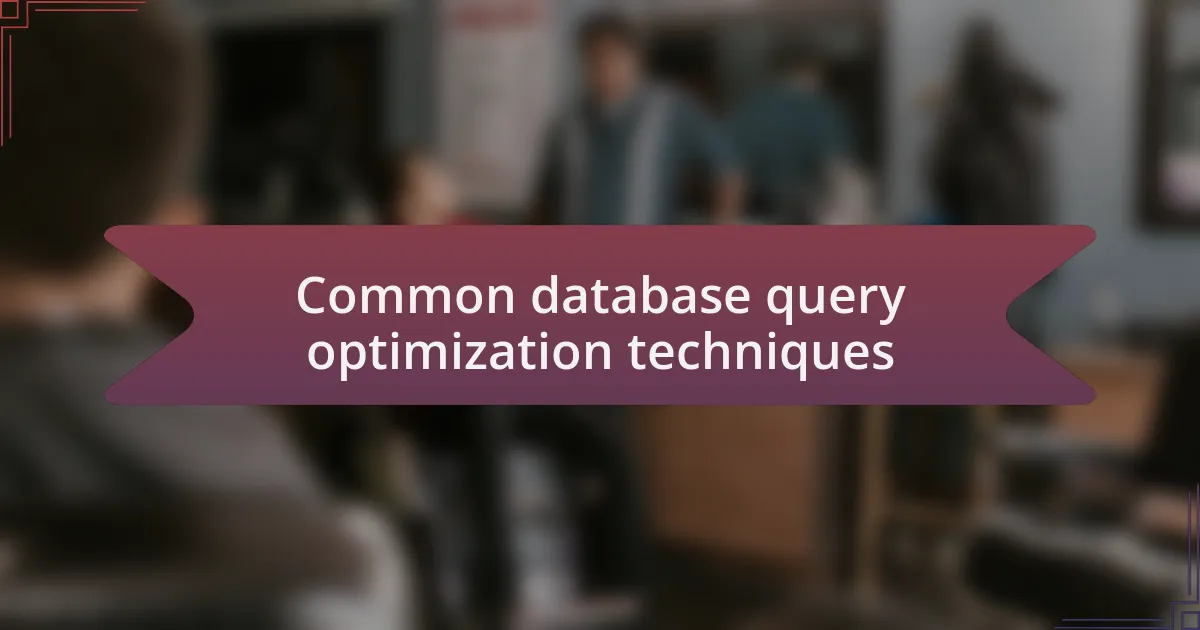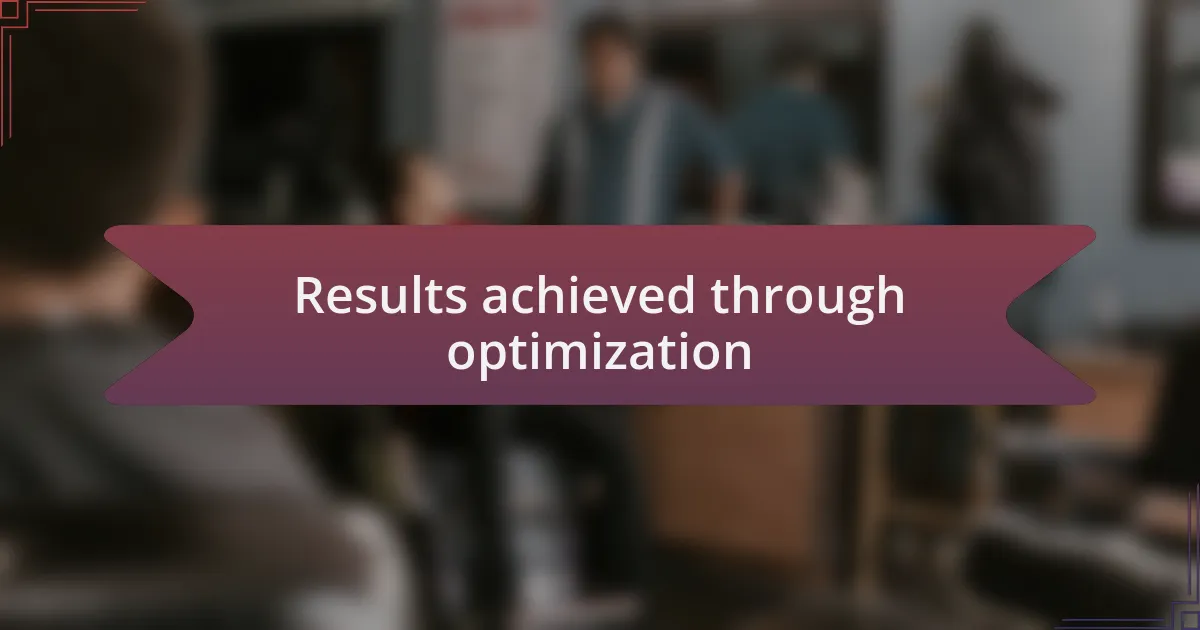Key takeaways:
- Optimized database queries are essential for enhancing application performance and user experience.
- Techniques such as indexing, using INNER JOIN over OUTER JOIN, and analyzing execution plans can significantly improve query efficiency.
- Collaboration and iterative testing are crucial for successful query optimization, helping to identify effective changes and avoid pitfalls.
- Measuring performance improvements requires establishing clear metrics and benchmarks to gauge the impact of optimizations accurately.

Understanding database queries importance
When I first started working with databases, I underestimated how crucial optimized queries were. I still remember the frustration of slow load times on a project—a simple search would churn for what felt like ages. It struck me then: the way we structure our queries can significantly impact the overall performance of an application.
Have you ever experienced a lagging website that made you click away in seconds? In my experience, poorly optimized database queries are often the hidden culprits behind such disappointments. It’s fascinating how a slight adjustment—like adding an index or refining a join—can reduce run times dramatically, transforming user experience from frustrating to fluid.
As I delved deeper into query optimization, I began to feel a connection between a developer’s skill and the satisfaction of end-users. Seeing those improvements reflected in the analytics—higher user retention and lower bounce rates—was immensely rewarding. This journey reinforced my belief that understanding and optimizing database queries is not just a technical necessity; it’s a vital part of creating a responsive, enjoyable digital experience.

Common database query optimization techniques
One of the first techniques I embraced was indexing, which essentially acts as a roadmap for the database. I remember implementing a simple index on a frequently queried column, and it felt like lifting a weight off my system. Suddenly, what used to take seconds transformed into blink-and-you-miss-it speed. Have you ever been surprised by how such a small change can yield such impressive results?
Another effective strategy I’ve found in my work is optimizing joins. Using INNER JOIN instead of OUTER JOIN when possible can simplify the results and improve performance. During a project, a few adjustments to how I connected tables led to query times slashing in half. It was a real eye-opener—how thoughtful structuring makes a world of difference in efficiency.
I cannot stress enough the importance of analyzing query execution plans. This practice gives you insight into how the database engine processes your queries. I recall poring over execution plans one evening and discovering that a poorly written subquery was dragging the entire operation down. It was surprisingly satisfying to see that, with a few refinements, I could dramatically improve performance. Isn’t it amazing how understanding the underlying mechanics can empower you to take control and enhance your applications?

Tools for analyzing query performance
When I first delved into tools for analyzing query performance, I discovered tools like EXPLAIN and EXPLAIN ANALYZE in PostgreSQL. I remember the thrill of running my queries through EXPLAIN and seeing the execution plan unfold. It was like having a backstage pass to how my queries ticked. Have you ever paused to consider what happens under the hood of your database commands?
Another tool that transformed my approach was SQL Server’s Database Engine Tuning Advisor. I once ran a set of slow queries through it and received recommendations that I could never have thought of on my own. I felt a blend of excitement and curiosity as I implemented its suggestions, watching performance metrics improve significantly. Isn’t it rewarding to see your database not just function, but thrive?
Lastly, I can’t underestimate the value of profiling tools like MySQL’s Query Profiler. During a project, I used it to identify performance bottlenecks in real-time, and the insights were eye-opening. I was able to pinpoint exactly which queries were acting sluggishly and why. Do you realize how profound it is to have those granular details at your fingertips? It completely reshaped how I tackled optimization.

My approach to query optimization
When it comes to my approach to query optimization, I always start with the analysis of the execution plan. I remember a time when I misjudged the complexity of a query; running it through EXPLAIN unveiled hidden inefficiencies that I had overlooked. This moment taught me the importance of really understanding how my database processes each command.
Next, I often focus on indexing strategies. There was a project where I revisited my indexing choices after noticing slow response times. By implementing a few targeted indexes, I witnessed a dramatic improvement. Have you ever felt that rush of excitement when a previously sluggish query suddenly zips through with speed? It’s validating, to say the least.
Lastly, I make it a habit to review and rewrite queries for optimization. I had a particularly convoluted query that, after some reflection, I realized could be broken down into simpler parts. Not only did this enhance performance, but it also made the code more maintainable. I think it’s fascinating how clarity and efficiency can go hand in hand when optimizing queries.

Challenges faced during optimization
Optimizing database queries isn’t without its hurdles. One of the significant challenges I’ve encountered is dealing with legacy systems that have accumulated years of poorly structured data and inefficient queries. It’s frustrating when you realize that the solution might require not just tweaking existing queries but a fundamental overhaul of how the data is stored and accessed. Have you ever felt that sinking feeling when you know the fix is going to take far longer than expected?
Another obstacle I often face is balancing optimization with maintainability. I recall a scenario where, in a quest for speed, I created a query that was lightning-fast but nearly impossible for others to understand. The excitement of seeing performance gains quickly faded when team members struggled to maintain the code. It’s a reminder that optimization shouldn’t come at the cost of clarity. How can we achieve efficiency and keep our codebase user-friendly?
Lastly, measuring the success of optimization can be tricky. I remember a time when I optimized a query but didn’t have a reliable benchmark to compare performance before and after. I was left wondering if my efforts had truly made an impact. This experience taught me the importance of establishing clear metrics and benchmarks for future optimizations. Isn’t it essential to know that our hard work is paying off in tangible results?

Lessons learned from my experience
One significant lesson I’ve learned is the importance of thoroughly understanding the existing data structure before diving into optimization. There was a time I hastily improved a query only to find it was preying on a fragile schema. The moment I realized my changes created more issues than they solved was truly eye-opening. Have you ever rushed into a solution, only to find yourself backtracking in frustration?
Another pivotal insight came from the realization that collaboration is key during the optimization process. When I first started, I tended to work in isolation, believing I could crack the code on my own. However, after sharing my optimization challenges with colleagues, I was surprised by the fresh perspectives they offered. Suddenly, those roadblocks felt less daunting. How often do we overlook the value of team input in our development efforts?
Lastly, I found that iterative testing is my best friend when it comes to optimization. Initially, I would make multiple changes at once, hoping for significant improvements. But I discovered that this approach often led to confusion. By adopting a more incremental method, I learned which adjustments truly made a difference. Wasn’t it liberating to shift from guessing to knowing what worked based on solid data?

Results achieved through optimization
Through my optimization efforts, I was astonished to see a drastic reduction in query execution times. One particular instance stands out: a complex report that used to take over ten seconds to run was transformed to under two seconds. The sense of achievement was overwhelming—it’s like inheriting a turbocharged engine after years of driving a clunky old car.
In another case, I remember reworking a heavily nested query that once strained the server during peak hours. After optimization, not only did the load time decrease, but we also experienced a noticeable drop in server errors. That moment felt gratifying, almost like discovering a hidden talent—an aspect of the system that, when fine-tuned, could perform remarkably without the constant hiccups we’d grown to accept. Have you ever felt that spark of realization when you solve a problem that had seemed insurmountable?
The most rewarding outcome has been the positive feedback from users. They noticed the enhancements immediately, and their satisfaction was the ultimate validation of my hard work. It’s easy to get lost in the technical details, but seeing users appreciate faster access reminded me why I love this field. Isn’t it refreshing to remember that our efforts ultimately aim to improve user experience?